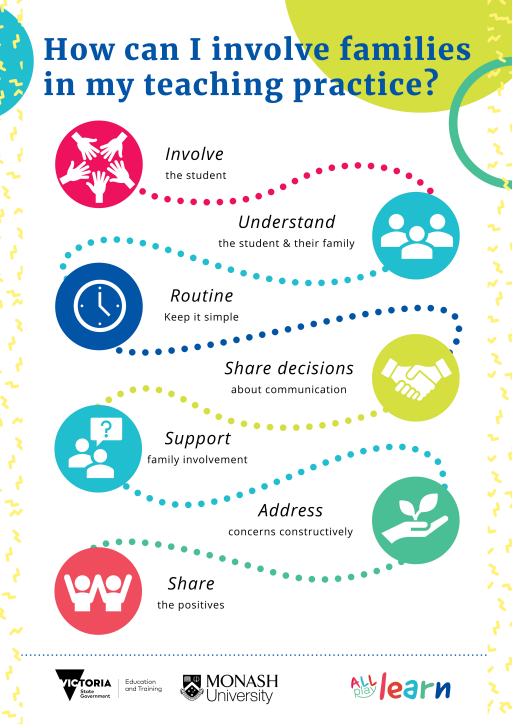Building successful partnerships between school and home
Successful partnerships between schools and families can help create consistency across home and school, and build a shared knowledge about a student’s strengths, abilities and identity. When schools and families work together, students are more motivated and engaged, and have better social and learning outcomes.


What is a successful partnership between schools and families?
Successful partnerships occur when schools and families (including the student):
- Recognise their shared responsibilities.
- Create a shared understanding of the student.
- Work together to set shared goals and strategies.
- Provide consistency across both school and home.
- Celebrate the achievements and progress of a student.

How can I involve families in my day-to-day teaching practice?
- Involve the student
- Develop an understanding of the student and their family
- Keep it simple; keep it routine
- Make decisions with families on how and when communication will occur
- Support family involvement in learning experiences and school community events
- Address concerns constructively
- Share the positives
- Involve students in discussions with their family, including when planning for their learning and support at school.
- Provide opportunities for students to share their work with their family.
For example, they could create a portfolio throughout the term, you could hold a brief showcase for families once a term, or students could email or take some work home to share.
- Be mindful of all students or families within your setting in how you approach family engagement, with particular sensitivity to students in out of home care, or students/families who may have experienced trauma, bereavement, family breakdown, or discrimination related to their identity.
- Visit our guide to considering the identities of students and their family, including information about how schools can create supportive environments for students and families who may have experienced trauma or marginalisation.
- Working together with families does not need to involve complicated systems or large amounts of your time. In fact, the simpler and more routine it is, the more likely it will be sustained.
- Use the tools that are available to you and can be easily slotted into your daily routine.
For example, use emails, notes, incidental chats at pick up or drop off, or the school learning management system. - Schedule time or follow a set routine for creating ongoing communication.
For example, send a brief class summary of learning highlights to all families each fortnight.Remember, the little things have a big impact!
- Individual families may have different preferences.
For example, consider whether verbal or written communication may be more accessible for some families (such as families who experience disability or are from culturally and linguistically diverse backgrounds) - Decide together whether the mode of communication should vary depending on the type of information being shared.
For example, some families may prefer concerns about a student’s learning and development are raised face-to-face. - Acknowledge that communication needs may change over time, and flexibility may be needed at times.
- Offer a range of opportunities for families to share their knowledge, skills or identity.
For example, invite families to visit or help in the classroom, or to share with the class (or school) information or experiences about their culture or disability. - Plan learning experiences that build connections to family identity or experience.
For example, an art project could include an option for students to engage with their families about ways they could use colours or design connected to their cultural identity.
- Start with the student’s strengths, and then discuss areas where supports may be needed.
- Allow the parent or carer to share their perspective, and hold a viewpoint that together you can identify a positive solution.
- Taking time to acknowledge a student’s strengths or successes can set a positive tone for partnerships between schools and families.

